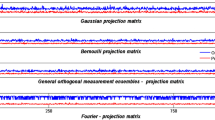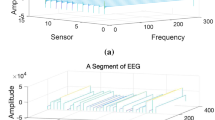Abstract
Compressive Sensing based ECG collecting system is an effective way for long time heart disease monitoring because of its precision as well as energy efficiency. Traditional Compressive Sensing methods are open-loop and the coordinator cannot obtain the recovery quality, which will impact the diagnosis results based on the recovered data. In this paper, a novel close-loop structure is designed for wireless ECG monitoring, which can maintain the recovery quality and the energy efficiency at a high level. Moreover, an improved Subspace Pursuit recovery method is designed to optimize the recovery quality. Simulations are made to prove that the recovery method is more efficient than most state-of-art recovery algorithm. Finally, an experimental testbed is built for evaluate the whole monitoring system. The results show that the recovery error can be controlled within the medical request while the energy efficiency can be improved by 12%.










Similar content being viewed by others
References
Chen H, Wu W, Lee J (2010) A wban-based real-time electroencephalogram monitoring system: design and implementation. J Med Syst 34(3):303–311
Alam MM, Berder O, Menard D, Sentieys O (2012) Tad-mac: traffic-aware dynamic mac protocol for wireless body area sensor networks. IEEE J Emerging Sel Top Circ Syst 2(1):109–119
Dixon AM, Allstot EG, Gangopadhyay D, Allstot DJ (2012) Compressed sensing system considerations for ecg and emg wireless biosensors. IEEE Trans Biomed Circ Syst 6(2):156– 166
Allstot EG, Chen AY, Dixon AM, Gangopadhyay D, Allstot DJ (2010) Compressive sampling of ecg bio-signals: quantization noise and sparsity considerations. In: 2010 IEEE biomedical circuits and systems conference (BioCAS). IEEE, pp 41–44
Haupt J, Bajwa WU, Rabbat M, Nowak R (2008) Compressed sensing for networked data. IEEE Signal Process Mag 25(2):92–101
Pati YC, Rezaiifar R, Krishnaprasad P (1993) Orthogonal matching pursuit: recursive function approximation with applications to wavelet decomposition. In: 1993. 1993 conference record of the twenty-seventh asilomar conference on signals, systems and computers. IEEE, pp 40–44
Donoho DL, Tsaig Y, Drori I, Starck J-L (2012) Sparse solution of underdetermined systems of linear equations by stagewise orthogonal matching pursuit. IEEE Trans Inf Theory 58(2):1094–1121
Needell D, Vershynin R (2010) Signal recovery from incomplete and inaccurate measurements via regularized orthogonal matching pursuit. IEEE J Sel Top Signal Process 4(2):310–316
Luo C, Wu F, Sun J, Chen C (2009) Compressive data gathering for large-scale wireless sensor networks. In: Proceedings of the 15th annual international conference on mobile computing and networking. ACM, pp 145–156
Chou CT, Rana R, Hu W (2009) Energy efficient information collection in wireless sensor networks using adaptive compressive sensing. In: 2009. LCN 2009. IEEE 34th conference on local computer networks. IEEE, pp 443–450
Haupt J, Nowak R, Castro R (2009) Adaptive sensing for sparse signal recovery. In: 2009. DSP/SPE 2009. IEEE 13th digital signal processing workshop and 5th IEEE signal processing education workshop. IEEE, pp 702–707
Haupt J, Castro R, Nowak R (2009) Distilled sensing: selective sampling for sparse signal recovery. In: International conference on artificial intelligence and statistics, pp 216–223
Aldroubi A, Wang H, Zarringhalam K (2011) Sequential adaptive compressed sampling via huffman codes. Sampling Theory Signal Image Process 10:3
Di Lorenzo P, Sayed AH (2013) Sparse distributed learning based on diffusion adaptation. IEEE Trans Signal Process 61(6):1419–1433
Zhao J, Bai X (2017) An improved orthogonal matching pursuit based on randomly enhanced adaptive subspace pursuit. In: 2017 asia-pacific signal and information processing association annual summit and conference (APSIPA ASC), pp 437–441
Ming Z, Ming-jiu L, Qing-hua Y, Ning M (2017) A new distributed subspace pursuit algorithm and its performance analysis. In: 2017 IEEE international conference on signal processing, communications and computing (ICSPCC), pp 1–5
Muduli PR, Mukherjee A (2017) A subspace projection-based joint sparse recovery method for structured biomedical signals. IEEE Trans Instrum Measur 66(2):234–242
Lai D, Zhang F, Wang C (2015) A real-time qrs complex detection algorithm based on differential threshold method. In: 2015 IEEE international conference on digital signal processing (DSP), pp 129–133
Yu W, Chen C, He T, Yang B, Guan X (2016) Adaptive compressive engine for real-time electrocardiogram monitoring under unreliable wireless channels. IET Commun 10(6):607–615
Acknowledgments
This work was supported by National Key Research and Development Program of China (2016YFB090190), National Natural Science Foundation of China (61803261), Shanghai Natural Science Foundation of China (18ZR1421100).
Author information
Authors and Affiliations
Corresponding author
Additional information
Publisher’s note
Springer Nature remains neutral with regard to jurisdictional claims in published maps and institutional affiliations.
This article is part of the Topical Collection: Special Issue on Big Data and Smart Computing in Network Systems
Guest Editors: Jiming Chen, Kaoru Ota, Lu Wang, and Jianping He
Rights and permissions
About this article
Cite this article
Yu, W., Chen, C., Liu, Z. et al. DSESP: Dual sparsity estimation subspace pursuit for the compressive sensing based close-loop ecg monitoring structure. Peer-to-Peer Netw. Appl. 12, 1311–1322 (2019). https://doi.org/10.1007/s12083-019-00731-5
Received:
Accepted:
Published:
Issue Date:
DOI: https://doi.org/10.1007/s12083-019-00731-5




